weight FIAT TALENTO 2020 Owner handbook (in English)
[x] Cancel search | Manufacturer: FIAT, Model Year: 2020, Model line: TALENTO, Model: FIAT TALENTO 2020Pages: 236, PDF Size: 4.86 MB
Page 67 of 236
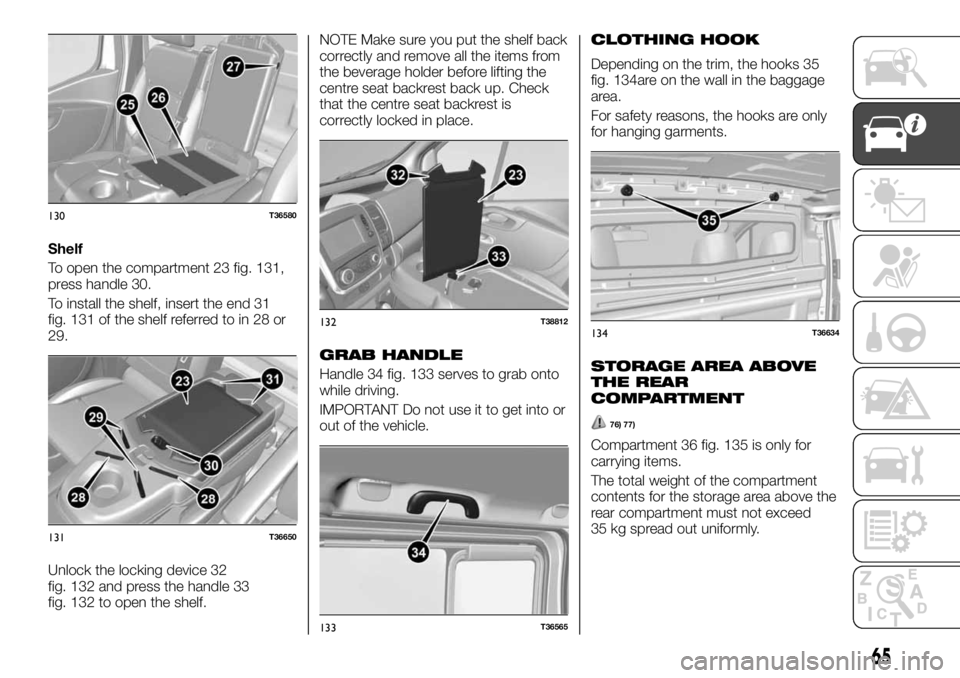
Shelf
To open the compartment 23 fig. 131,
press handle 30.
To install the shelf, insert the end 31
fig. 131 of the shelf referred to in 28 or
29.
Unlock the locking device 32
fig. 132 and press the handle 33
fig. 132 to open the shelf.NOTE Make sure you put the shelf back
correctly and remove all the items from
the beverage holder before lifting the
centre seat backrest back up. Check
that the centre seat backrest is
correctly locked in place.
GRAB HANDLE
Handle 34 fig. 133 serves to grab onto
while driving.
IMPORTANT Do not use it to get into or
out of the vehicle.
CLOTHING HOOK
Depending on the trim, the hooks 35
fig. 134are on the wall in the baggage
area.
For safety reasons, the hooks are only
for hanging garments.
STORAGE AREA ABOVE
THE REAR
COMPARTMENT
76) 77)
Compartment 36 fig. 135 is only for
carrying items.
The total weight of the compartment
contents for the storage area above the
rear compartment must not exceed
35 kg spread out uniformly.
130T36580
131T36650
132T38812
133T36565
134T36634
65
Page 107 of 236
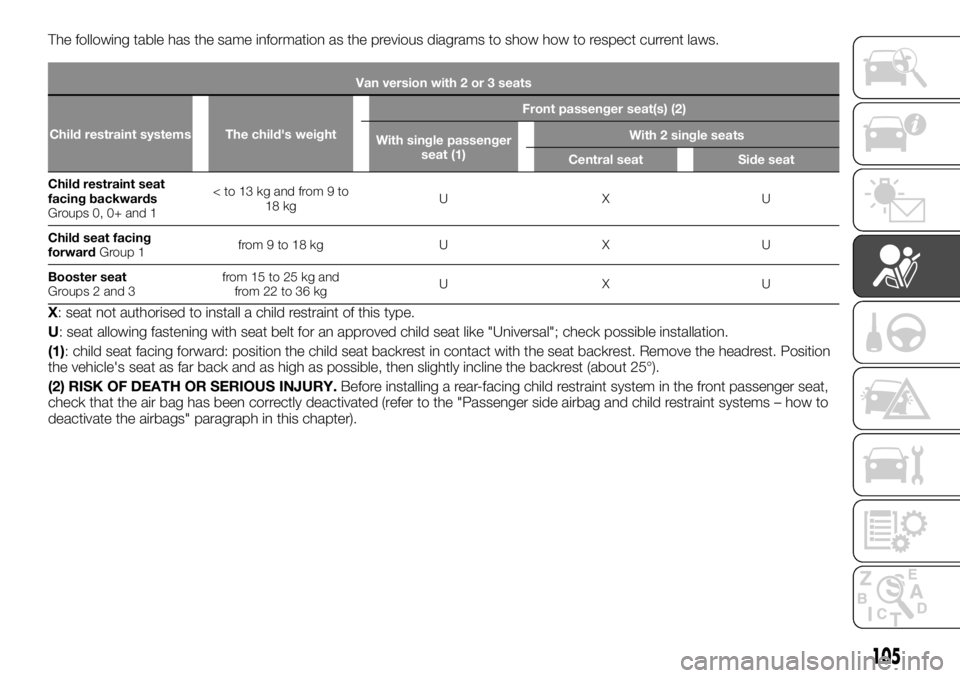
The following table has the same information as the previous diagrams to show how to respect current laws.
Van version with 2 or 3 seats
Child restraint systems The child's weightFront passenger seat(s) (2)
With single passenger
seat (1)With 2 single seats
Central seat Side seat
Child restraint seat
facing backwards
Groups 0, 0+ and 1
Child seat facing
forwardGroup 1from9to18kg U X U
Booster seatfrom 15 to 25 kg and
from 22 to 36 kgUXU
X: seat not authorised to install a child restraint of this type.
U: seat allowing fastening with seat belt for an approved child seat like "Universal"; check possible installation.
(1): child seat facing forward: position the child seat backrest in contact with the seat backrest. Remove the headrest. Position
the vehicle's seat as far back and as high as possible, then slightly incline the backrest (about 25°).
(2) RISK OF DEATH OR SERIOUS INJURY.Before installing a rear-facing child restraint system in the front passenger seat,
check that the air bag has been correctly deactivated (refer to the "Passenger side airbag and child restraint systems – how to
deactivate the airbags" paragraph in this chapter).
105
Groups 2 and 3
Page 109 of 236
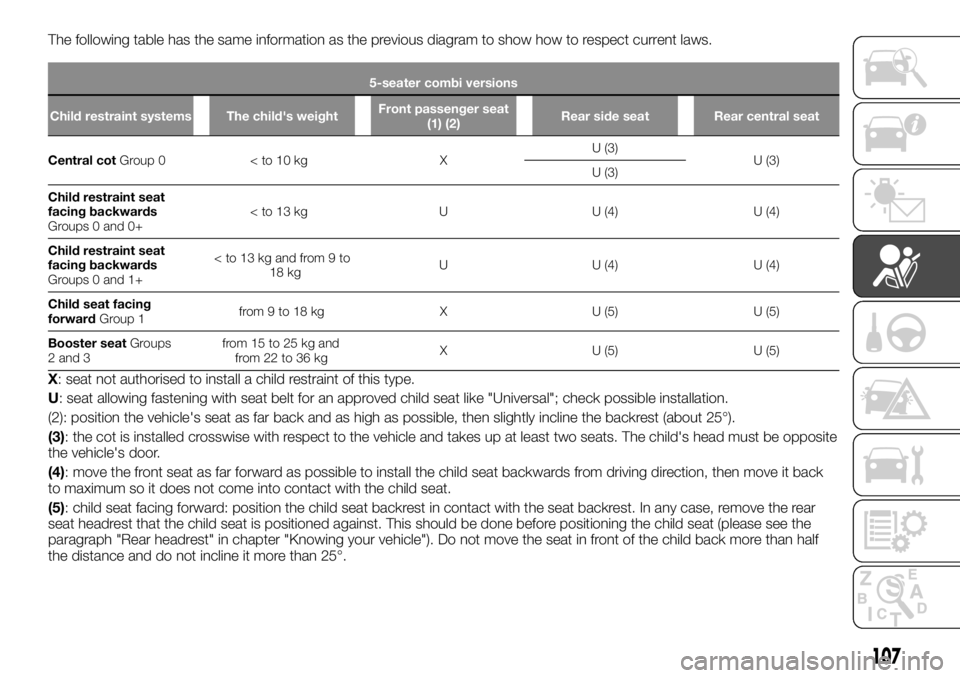
The following table has the same information as the previous diagram to show how to respect current laws.
5-seater combi versions
Child restraint systems The child's weightFront passenger seat
(1) (2)Rear side seat Rear central seat
Central cotGroup 0 < to 10 kg XU (3)
U (3)
U (3)
Child restraint seat
facing backwards
Groups 0 and 0+
facing backwards
Groups 0 and 1+
Child seat facing
forwardGroup 1from9to18kg X U(5) U(5)
Booster seatGroups
2 and 3from 15 to 25 kg and
from 22 to 36 kgX U (5) U (5)
X: seat not authorised to install a child restraint of this type.
U: seat allowing fastening with seat belt for an approved child seat like "Universal"; check possible installation.
(2): position the vehicle's seat as far back and as high as possible, then slightly incline the backrest (about 25°).
(3): the cot is installed crosswise with respect to the vehicle and takes up at least two seats. The child's head must be opposite
the vehicle's door.
(4): move the front seat as far forward as possible to install the child seat backwards from driving direction, then move it back
to maximum so it does not come into contact with the child seat.
(5): child seat facing forward: position the child seat backrest in contact with the seat backrest. In any case, remove the rear
seat headrest that the child seat is positioned against. This should be done before positioning the child seat (please see the
paragraph "Rear headrest" in chapter "Knowing your vehicle"). Do not move the seat in front of the child back more than half
the distance and do not incline it more than 25°.
107
Page 111 of 236
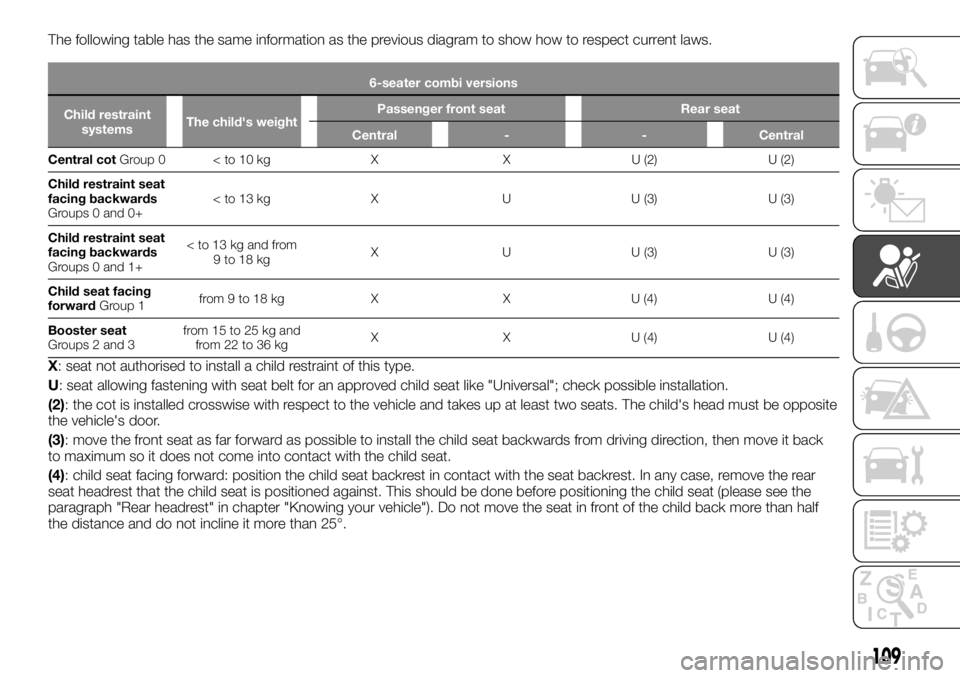
The following table has the same information as the previous diagram to show how to respect current laws.
6-seater combi versions
Child restraint
systemsThe child's weightPassenger front seat Rear seat
Central - - Central
Central cotGr
oup 0
facing backwards
Groups 0 and 0+
facing backwards
Groups 0 and 1+
Child seat facing
forwardGroup 1from 9 to 18 kg X X U (4) U (4)
Booster seat
Groups 2 and 3from 15 to 25 kg and
from 22 to 36 kgX X U (4) U (4)
X: seat not authorised to install a child restraint of this type.
U: seat allowing fastening with seat belt for an approved child seat like "Universal"; check possible installation.
(2): the cot is installed crosswise with respect to the vehicle and takes up at least two seats. The child's head must be opposite
the vehicle's door.
(3): move the front seat as far forward as possible to install the child seat backwards from driving direction, then move it back
to maximum so it does not come into contact with the child seat.
(4): child seat facing forward: position the child seat backrest in contact with the seat backrest. In any case, remove the rear
seat headrest that the child seat is positioned against. This should be done before positioning the child seat (please see the
paragraph "Rear headrest" in chapter "Knowing your vehicle"). Do not move the seat in front of the child back more than half
the distance and do not incline it more than 25°.
109
Page 113 of 236
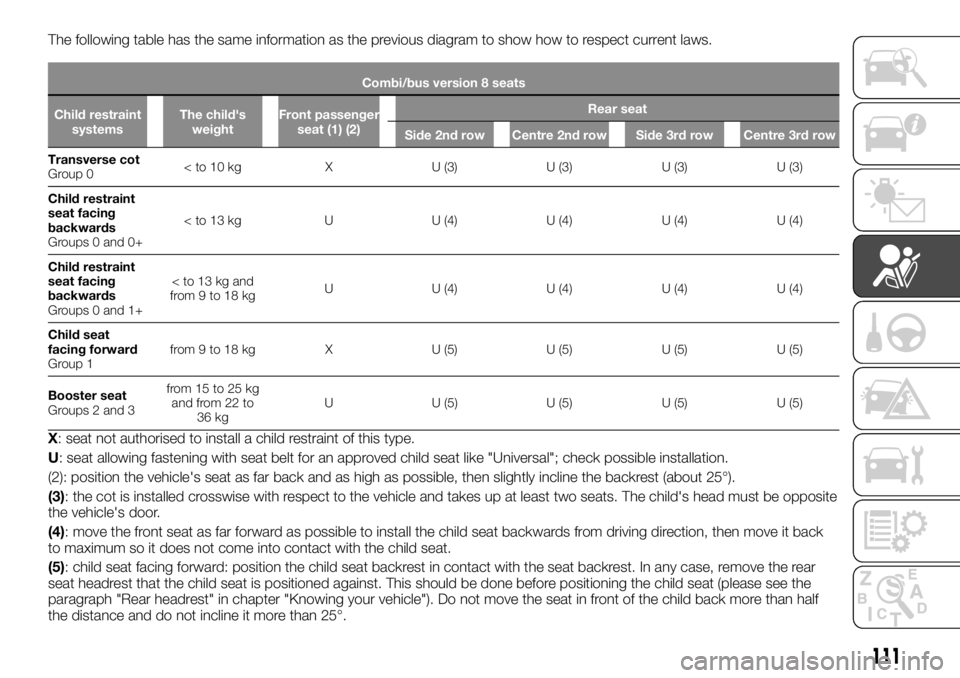
The following table has the same information as the previous diagram to show how to respect current laws.
Combi/bus version 8 seats
Child restraint
systemsThe child's
weightFront passenger
seat (1) (2)Rear seat
Side 2nd row Centre 2nd row Side 3rd row Centre 3rd row
Transverse cot
Gr
oup 0
seat facing
backwards
Groups 0 and 0+< to 13 kg U U (4) U (4) U (4) U (4)
Child restraint
seat facing
backwards
Groups 0 and 1+
Child seat
facing forward
Group 1from 9 to 18 kg X U (5) U (5) U (5) U (5)
Booster seat
Groups 2 and 3from 15 to 25 kg
and from 22 to
36 kgU U (5) U (5) U (5) U (5)
X: seat not authorised to install a child restraint of this type.
U: seat allowing fastening with seat belt for an approved child seat like "Universal"; check possible installation.
(2): position the vehicle's seat as far back and as high as possible, then slightly incline the backrest (about 25°).
(3): the cot is installed crosswise with respect to the vehicle and takes up at least two seats. The child's head must be opposite
the vehicle's door.
(4): move the front seat as far forward as possible to install the child seat backwards from driving direction, then move it back
to maximum so it does not come into contact with the child seat.
(5): child seat facing forward: position the child seat backrest in contact with the seat backrest. In any case, remove the rear
seat headrest that the child seat is positioned against. This should be done before positioning the child seat (please see the
paragraph "Rear headrest" in chapter "Knowing your vehicle"). Do not move the seat in front of the child back more than half
the distance and do not incline it more than 25°.
111
Page 115 of 236
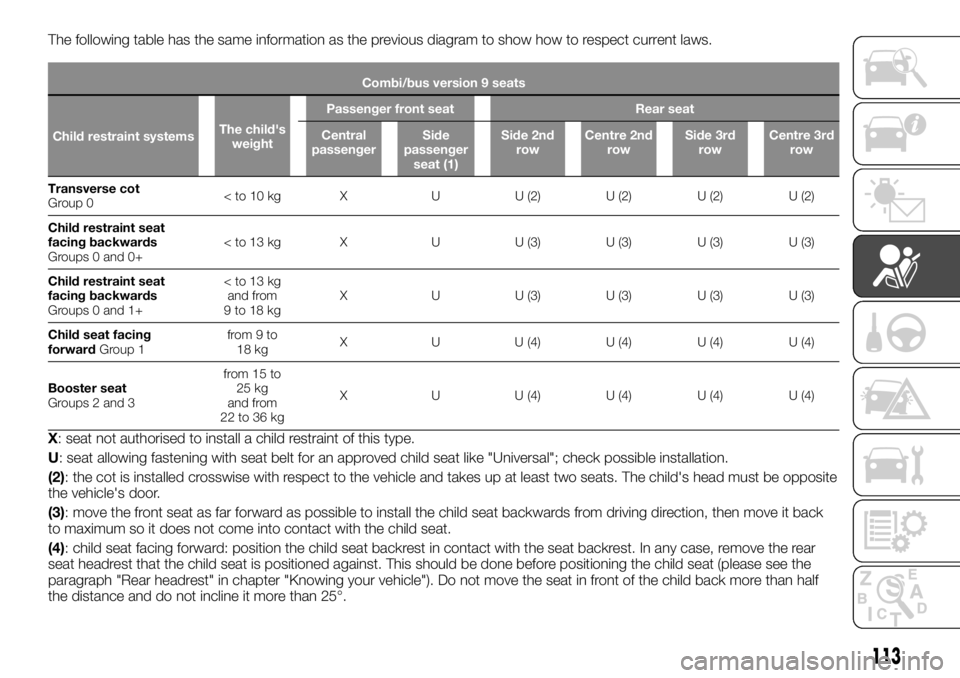
The following table has the same information as the previous diagram to show how to respect current laws.
Combi/bus version 9 seats
Child restraint systemsThe child's
weightPassenger front seat Rear seat
Central
passengerSide
passenger
seat (1)Side 2nd
rowCentre 2nd
rowSide 3rd
rowCentre 3rd
row
Transverse cot
Group 0
facing backwards
Groups 0 and 0+< to 13 kg X U U (3) U (3) U (3) U (3)
Child restraint seat
facing backwards
Groups 0 and 1+
9to18kgX U U (3) U (3) U (3) U (3)
Child seat facing
forwardGroup 1from 9 to
18 kgX U U (4) U (4) U (4) U (4)
Booster seat
Groups 2 and 3from 15 to
25 kg
and from
22 to 36 kgX U U (4) U (4) U (4) U (4)
X: seat not authorised to install a child restraint of this type.
U: seat allowing fastening with seat belt for an approved child seat like "Universal"; check possible installation.
(2): the cot is installed crosswise with respect to the vehicle and takes up at least two seats. The child's head must be opposite
the vehicle's door.
(3): move the front seat as far forward as possible to install the child seat backwards from driving direction, then move it back
to maximum so it does not come into contact with the child seat.
(4): child seat facing forward: position the child seat backrest in contact with the seat backrest. In any case, remove the rear
seat headrest that the child seat is positioned against. This should be done before positioning the child seat (please see the
paragraph "Rear headrest" in chapter "Knowing your vehicle"). Do not move the seat in front of the child back more than half
the distance and do not incline it more than 25°.
113
Page 116 of 236
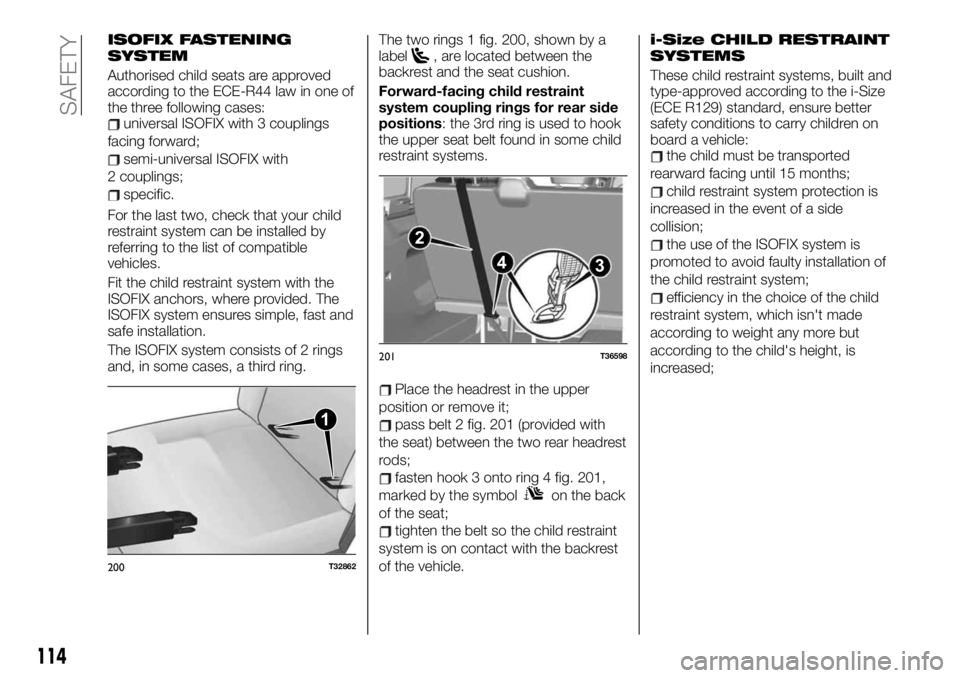
ISOFIX FASTENING
SYSTEM
Authorised child seats are approved
according to the ECE-R44 law in one of
the three following cases:
universal ISOFIX with 3 couplings
facing forward;
semi-universal ISOFIX with
2 couplings;
specific.
For the last two, check that your child
restraint system can be installed by
referring to the list of compatible
vehicles.
Fit the child restraint system with the
ISOFIX anchors, where provided. The
ISOFIX system ensures simple, fast and
safe installation.
The ISOFIX system consists of 2 rings
and, in some cases, a third ring.The two rings 1 fig. 200, shown by a
label
, are located between the
backrest and the seat cushion.
Forward-facing child restraint
system coupling rings for rear side
positions: the 3rd ring is used to hook
the upper seat belt found in some child
restraint systems.
Place the headrest in the upper
position or remove it;
pass belt 2 fig. 201 (provided with
the seat) between the two rear headrest
rods;
fasten hook 3 onto ring 4 fig. 201,
marked by the symbol
on the back
of the seat;
tighten the belt so the child restraint
system is on contact with the backrest
of the vehicle.
i-Size CHILD RESTRAINT
SYSTEMS
These child restraint systems, built and
type-approved according to the i-Size
(ECE R129) standard, ensure better
safety conditions to carry children on
board a vehicle:
the child must be transported
rearward facing until 15 months;
child restraint system protection is
increased in the event of a side
collision;
the use of the ISOFIX system is
promoted to avoid faulty installation of
the child restraint system;
efficiency in the choice of the child
restraint system, which isn't made
according to weight any more but
according to the child's height, is
increased;
1
200T32862
2
3 4
201T36598
114
SAFETY
Page 120 of 236
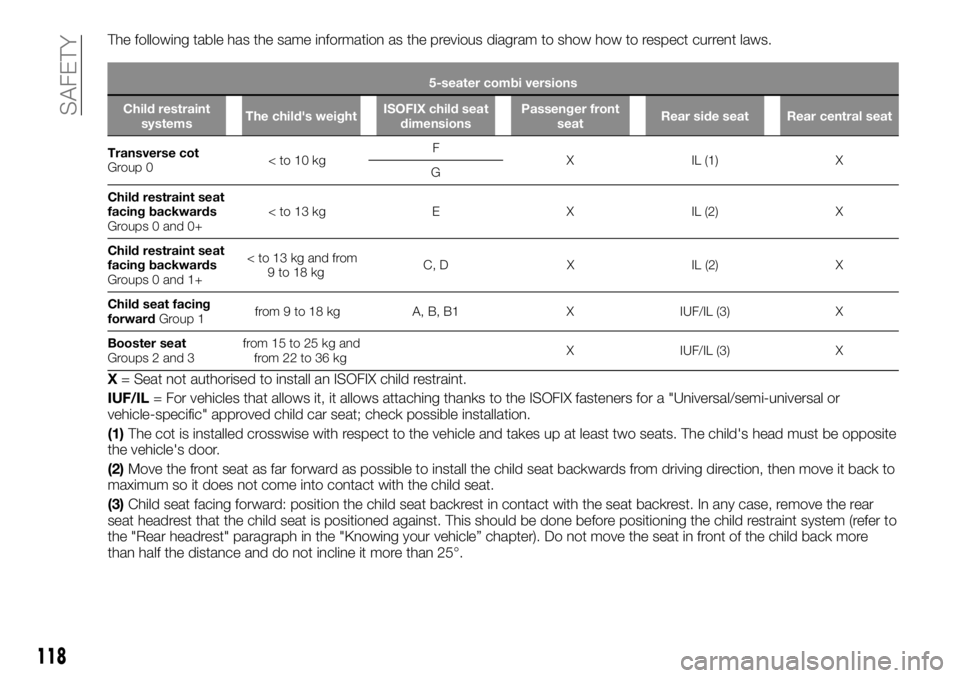
The following table has the same information as the previous diagram to show how to respect current laws.
5-seater combi versions
Child restraint
systemsThe child's weightISOFIX child seat
dimensionsPassenger front
seatRear side seat Rear central seat
Transverse cot
Group 0
G
Child restraint seat
facing backwards
Groups 0 and 0+
facing backwards
Groups 0 and 1+
Child seat facing
forwardGroup 1from 9 to 18 kg A, B, B1 X IUF/IL (3) X
Booster seat
Groups 2 and 3from 15 to 25 kg and
from 22 to 36 kgX IUF/IL (3) X
X= Seat not authorised to install an ISOFIX child restraint.
IUF/IL= For vehicles that allows it, it allows attaching thanks to the ISOFIX fasteners for a "Universal/semi-universal or
vehicle-specific" approved child car seat; check possible installation.
(1)The cot is installed crosswise with respect to the vehicle and takes up at least two seats. The child's head must be opposite
the vehicle's door.
(2)Move the front seat as far forward as possible to install the child seat backwards from driving direction, then move it back to
maximum so it does not come into contact with the child seat.
(3)Child seat facing forward: position the child seat backrest in contact with the seat backrest. In any case, remove the rear
seat headrest that the child seat is positioned against. This should be done before positioning the child restraint system (refer to
the "Rear headrest" paragraph in the "Knowing your vehicle” chapter). Do not move the seat in front of the child back more
than half the distance and do not incline it more than 25°.
118
SAFETY
Page 122 of 236
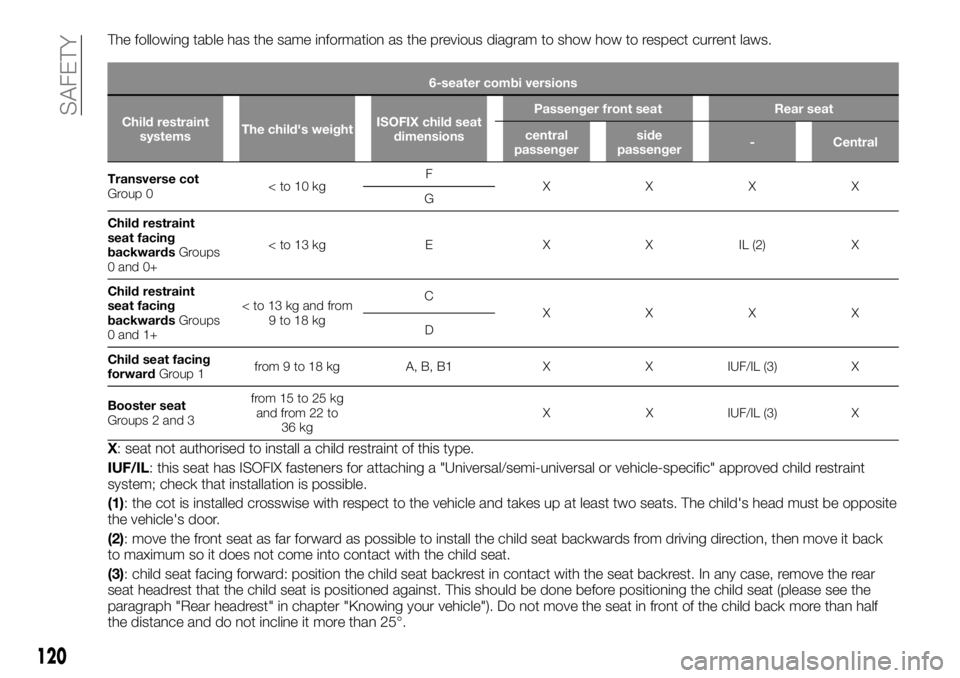
The following table has the same information as the previous diagram to show how to respect current laws.
6-seater combi versions
Child restraint
systemsThe child's weightISOFIX child seat
dimensionsPassenger front seat Rear seat
central
passengerside
passenger- Central
Transverse cot
Group 0
XXXX
G
Child restraint
seat facing
backwardsGroups
0 and 0+
seat facing
backwardsGroups
0 and 1+
XXXX
D
Child seat facing
forwardGroup 1from 9 to 18 kg A, B, B1 X X IUF/IL (3) X
Booster seat
Groups 2 and 3from 15 to 25 kg
and from 22 to
36 kgX X IUF/IL (3) X
X: seat not authorised to install a child restraint of this type.
IUF/IL: this seat has ISOFIX fasteners for attaching a "Universal/semi-universal or vehicle-specific" approved child restraint
system; check that installation is possible.
(1): the cot is installed crosswise with respect to the vehicle and takes up at least two seats. The child's head must be opposite
the vehicle's door.
(2): move the front seat as far forward as possible to install the child seat backwards from driving direction, then move it back
to maximum so it does not come into contact with the child seat.
(3): child seat facing forward: position the child seat backrest in contact with the seat backrest. In any case, remove the rear
seat headrest that the child seat is positioned against. This should be done before positioning the child seat (please see the
paragraph "Rear headrest" in chapter "Knowing your vehicle"). Do not move the seat in front of the child back more than half
the distance and do not incline it more than 25°.
120
SAFETY
Page 124 of 236
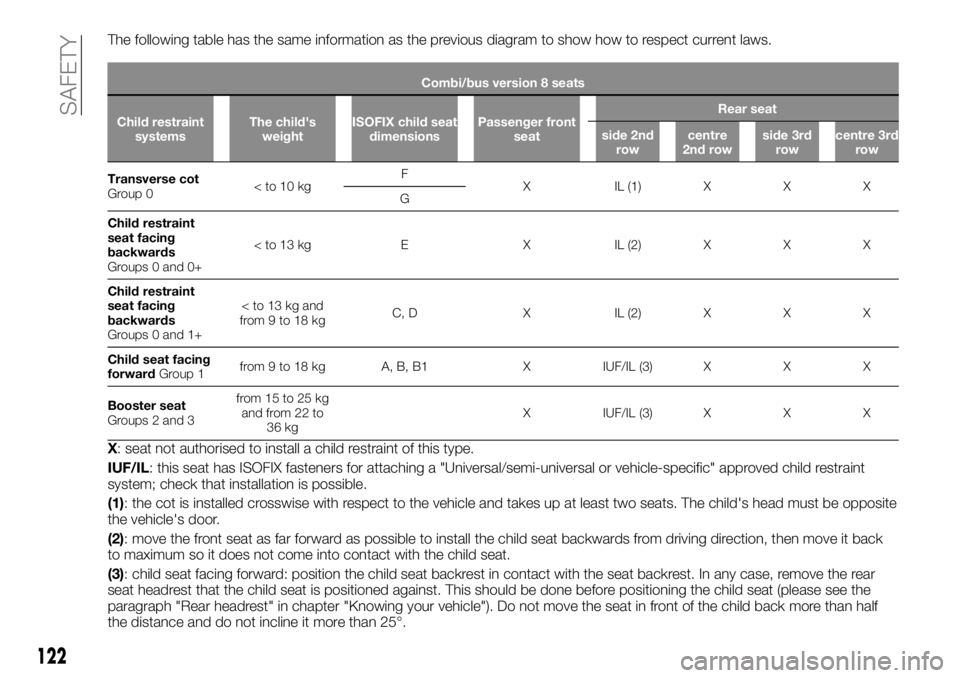
The following table has the same information as the previous diagram to show how to respect current laws.
Combi/bus version 8 seats
Child restraint
systemsThe child's
weightISOFIX child seat
dimensionsPassenger front
seatRear seat
side 2nd
rowcentre
2nd rowside 3rd
rowcentre 3rd
row
Transverse cot
Group 0
X IL (1) X X X
G
Child restraint
seat facing
backwards
Groups 0 and 0+
seat facing
backwards
Groups 0 and 1+
Child seat facing
forwardGroup 1from 9 to 18 kg A, B, B1 X IUF/IL (3) X X X
Booster seat
Groups 2 and 3from 15 to 25 kg
and from 22 to
36 kgX IUF/IL (3) X X X
X: seat not authorised to install a child restraint of this type.
IUF/IL: this seat has ISOFIX fasteners for attaching a "Universal/semi-universal or vehicle-specific" approved child restraint
system; check that installation is possible.
(1): the cot is installed crosswise with respect to the vehicle and takes up at least two seats. The child's head must be opposite
the vehicle's door.
(2): move the front seat as far forward as possible to install the child seat backwards from driving direction, then move it back
to maximum so it does not come into contact with the child seat.
(3): child seat facing forward: position the child seat backrest in contact with the seat backrest. In any case, remove the rear
seat headrest that the child seat is positioned against. This should be done before positioning the child seat (please see the
paragraph "Rear headrest" in chapter "Knowing your vehicle"). Do not move the seat in front of the child back more than half
the distance and do not incline it more than 25°.
122
SAFETY